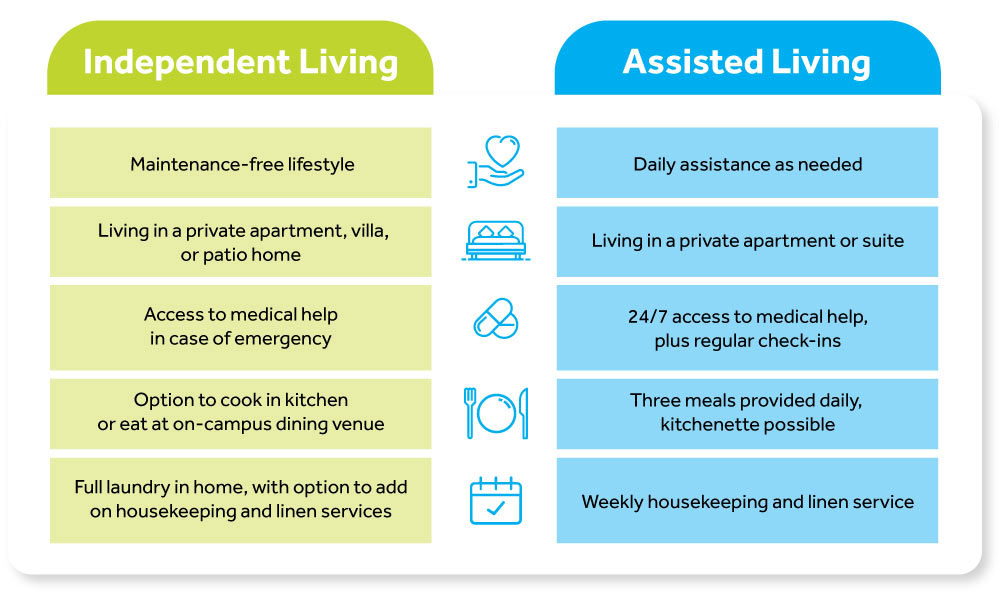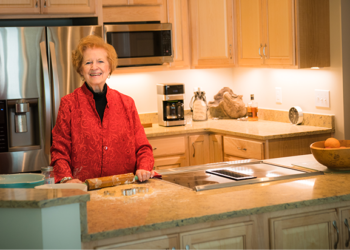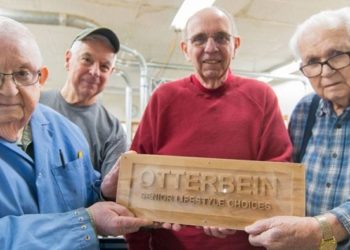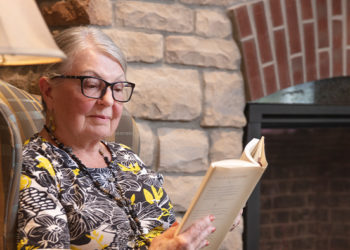What’s the Difference Between
Independent and Assisted Living?
The primary difference between independent and assisted living is the level of assistance the resident requires with daily activities.
- Independent living – designed for active lifestyles and often features maintenance-free living, amenities, activities and outings, 24-hour emergency services, dining options, and access to continuing care (if needed)
- Assisted living – appropriate for individuals who need help with some of life’s daily activities, like meals, bathing, housekeeping, laundry, and transportation; typically includes the same amenities as independent living
If you’re thinking about a senior living community for yourself or a loved one, you may be wondering which level of care is best. Take our interactive quiz to help determine whether independent or assisted living is right for you. Just remember — only you, along with the advice of a medical or senior care professional, can decide which option is best.
Download Our Free Independent and Assisted Living Guide
Click the button below to download your free copy of our guide to understanding the similarities and differences between independent and assisted living.
Independent Living vs. Assisted Living

Frequently Asked Questions
First, if you haven’t taken the quiz above, go ahead and do so. Second, look at their current lifestyle and needs. How often do you feel you need to check in on them to make sure they’re safe? Every day? Every week? Or just occasionally?
Also, what do they seem to need the most help with? Do they just need a hand keeping up the house, fixing things that are broken, or mowing the lawn? Or do they have trouble physically moving around or keeping up on their hygiene?
If your concerns about your parents’ lifestyle are mainly minor and revolve around inconveniences like maintenance and upkeep, independent living could be a good option to provide them with additional freedom and convenience.
On the other hand, if you’re concerned for your parents’ safety and physical and mental health, assisted living could be the way to go.
If you find yourself in this scenario, one of the best things you can do is bring your loved one to one of our Otterbein communities for a visit. Be sure to let them know that you are not trying to pressure them into something that is not right for them, but just the opposite.
Once you’re here, our SeniorLife Counselors can help show you and your loved one what life could be like for them in assisted living. Chances are that seeing our community in person and meeting our residents could help open their mind to the possibilities and advantages of assisted living.
Rest assured: we will do everything we can to make reasonable accommodations so your loved one’s needs are met. We can keep you updated on how things are going and adjust as necessary.
If it turns out that your loved one indeed needs assisted living, don’t panic. We have helped many people make this transition with minimal disruption to their lifestyle, and we can do the same for you and your loved one. One of the advantages of living in a Continuing Care Retirement Community (CCRC) is that moving from one level of care to another is much easier for residents and their families.
The answer is different for everyone and every situation. Be sure to look at the advantages and disadvantages of both, and talk early and often with your loved one about both options. There are lots of resources you can use as you make your decision, such as:
- Get started with these helpful resources designed for family members and loved ones to begin their senior living search.
- Read blog articles or ask friends/family members who’ve been through this before.
- Set up a visit to one of our Otterbein communities.
- Check out this Ultimate Guide to Life at Otterbein for more questions and answers to common questions.
- Download this free guide to independent living vs. assisted living.
- Contact us at Otterbein SeniorLife for more information or to simply ask questions.










